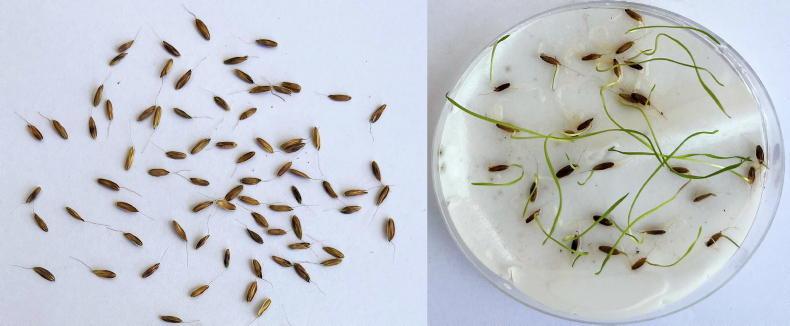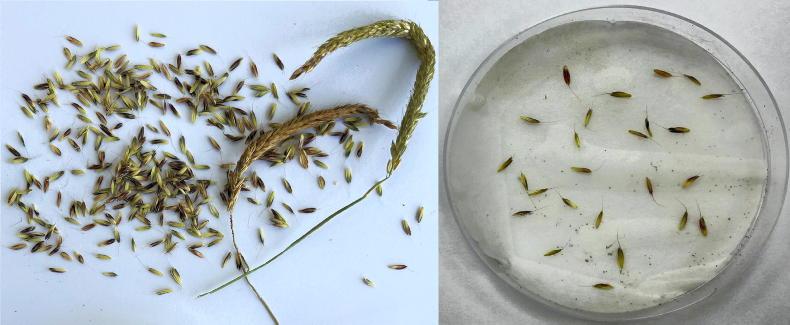Researchers at Teagasc will test seeds from all grass and broad-leaved weeds suspected of being herbicide resistant. This is an invaluable free resistance-testing service funded by Teagasc and the Department of Agriculture, Food and the Marine’s EVOLVE grass-weed project.In the past few weeks in the Irish Farmers Journal, we have reported 80% of blackgrass or 100% of Italian ryegrass tested from suspect samples taken in harvest 2022 were resistant to ACCase and/or ALS herbicides. We also documented the first confirmed ALS- and 2,4 D-resistant poppies.
Researchers at Teagasc will test seeds from all grass and broad-leaved weeds suspected of being herbicide resistant. This is an invaluable free resistance-testing service funded by Teagasc and the Department of Agriculture, Food and the Marine’s EVOLVE grass-weed project.
In the past few weeks in the Irish Farmers Journal, we have reported 80% of blackgrass or 100% of Italian ryegrass tested from suspect samples taken in harvest 2022 were resistant to ACCase and/or ALS herbicides. We also documented the first confirmed ALS- and 2,4 D-resistant poppies.
It is important to check whether any of these weeds are resistant to the herbicides used to control them. However, in the case of blackgrass, the first priority has to be to remove the plants from the field and only then consider whether good seed samples can be secured.
What symptoms indicate resistance to the herbicide used?
Herbicide resistance may go unnoticed initially due to low plant numbers that are resistant, and symptoms at first may look like a weed escaped or a small irregular weed patch.
However, these resistant plants can quickly become dominant, especially where the same herbicides are used repeatedly. Visual symptoms of suspected resistance post the application of a herbicide (Figure 1) include:
A mix of healthy and dead plants of the same species. Inadequate control of one species alongside other susceptible species well-controlled. Observations
It is important to conduct resistance testing rather than relying on your own judgment and field observations.
Because your weed population is resistant to one herbicide, does not necessarily mean that it is resistant to every other herbicide within the same group.
As predicting the patterns of cross resistance is difficult in field resulting in uncertainty about herbicide use; glasshouse testing will confirm it; the herbicide types involved; and also whether it is target site (resistant to specific herbicide groups) or non-target site (broad-ranging tolerance to multiple groups).
How to collect and submit seed samples for resistance testing?
Resistance tests are only as good as the sample collected. The below steps will help you collect and submit a good seed sample.
1 Collect as follows:
Fields with small populations: walk and sample all or most of the affected area. Fields with heavy infestations, ensure you get a representative sample by systematically sampling the field using the number of tramlines as a base.Bulk the seed samples.Do not mix seeds from different fields or species.2 Seeds should be collected when they are ripe and easily fall-off from their seed heads, and those mature shatter seeds will germinate rapidly (Figure 2A). Unripe seeds will not germinate (Figure 2B).

Figure 2A.

Figure 2B.
3 While identification and mapping of problem weeds should be carried out in June, ripe seeds should be collected in mid-July to early-August (mid/late June for winter barley).
4 Sample as follows:
For grass weeds: cut-off the mature seed heads directly into a paper envelope. Gently rub the heads or shake vigorously inside the envelope (this process should be carried out in a secure area away from the field to prevent seed escape). Collect seeds on dry days, but if damp allow them to dry (away from sunlight) before threshing.For broadleaved weeds: cut off the mature heads and place them directly in a paper envelope and keep the paper envelope open for a couple of days to allow further drying of the seed heads. If polythene bags are used, transfer the samples immediately to paper envelopes. Never store or transport samples in polythene bags.
5 We need large quantities of seed to test every weed against all labelled herbicides that have activity on that weed.
For smaller seeds (eg blackgrass, Italian ryegrass), one to two mugs (0.5l) of seeds. For larger seeds (eg wild oats, brome), one to two pints (0.8l), a glass of seeds. 6 It is essential that you fill out the herbicide resistance testing form or the sample will not be tested. Accurate details of the field history of the sample received is key to understand reasons for variation in sensitivity. The form is available online or from your Teagasc adviser or agronomist.
7 Send the paper envelope of dry seeds along with the completed resistance testing form to Teagasc Oak Park Crops Research Centre, Carlow, R93 XE12 or deliver by hand to Teagasc main reception desk, Oak Park, Carlow.
8 For queries, you can contact:
Charlotte Morgan, EVOLVE PhD on 087-3254500/059-9183525 or email Charlotte.Morgan@teagasc.ieGerry Nolan, EVOLVE technician, on 087-7598061/059-9183558 or email Gerry.Nolan@teagasc.ieVijaya Bhaskar, weed researcher on 087-0609409/059-9170248 or email Vijaya.Bhaskar@teagasc.ie
Figure 3.
As most grass weeds have a dormancy period, initial testing will not begin until four to seven weeks after seeds arrive. We conduct different types of tests to detect resistance in the population.
The most common type is glasshouse seed testing.
Different post-emergence herbicides are tested on the young plants (at the two- to three-leaf stage for grass weeds or four- to six-leaf stage for broadleaved weeds) grown from weed seed samples and compared with known-sensitive or resistant populations.
Visual assessments for plant survival will be conducted 28 to 35 days post-spraying.
For pre-emergence herbicides, treatments will be applied on unchit or chit seeds immediately after sowing. Detailed dose-response and molecular assays will be conducted on those showing less sensitivity or resistance.
In some cases, we conduct glasshouse testing on plants rather than seeds, where surviving plants are collected from problem fields, allowed to regrow and are then sprayed and tested with different post-emergence herbicides.
We also conduct lab petri-dish seed assays.
The seeds will be grown in herbicide solutions and seedling growth will be evaluated after 14 days.
For example, we test seedling growth in pendimethalin (pre-emergence) herbicide solutions; and pendimethalin resistance is used as a proxy for non-target-site resistance in grass weeds. This quick test is not suited to all weed/herbicide types.
Herbicides used in the glasshouse screening for grass and
broadleaved weeds
Blackgrass: Falcon, Stratos, Centurion, Pacifica, Glyphosate.Italian ryegrass: Axial, Falcon, Stratos, Centurion, Pacifica or Monolith, Broadway, Glyphosate.Wild oats: Axial, Falcon, Stratos, Pacifica or Monolith, Broadway.Bromes: Falcon, Stratos, Pacifica, Broadway.Meadow grass: Pacifica, Falcon, Centurion, Glyphosate.Common poppy: Ally Max, Cameo Max, Arylex, 2,4 D.Chickweed: Ally Max, Boxer, Hurler, CMPP, Arylex.Corn marigold: Ally Max, Dowshield, Galaxy.As new cases of herbicide resistance pop up, proactive weed resistance testing is critical.Screening results are farm-specific. Never use one farm’s results to predict another.In the absence of resistance tests, you lose not just a season of knowing what population you are dealing with, but also potentially recharging soil seedbanks, making control options even more challenging. Resistance testing is critical in fields, especially where blackgrass, Italian ryegrass or common poppy is present.To provide early warning of problems, plan ahead and look at steps to take to mitigate the problem with correct herbicide types and integrated control strategies. If you suspect herbicide resistance, this is a unique opportunity to get that tested. Be vigilant. Act now! 




SHARING OPTIONS: